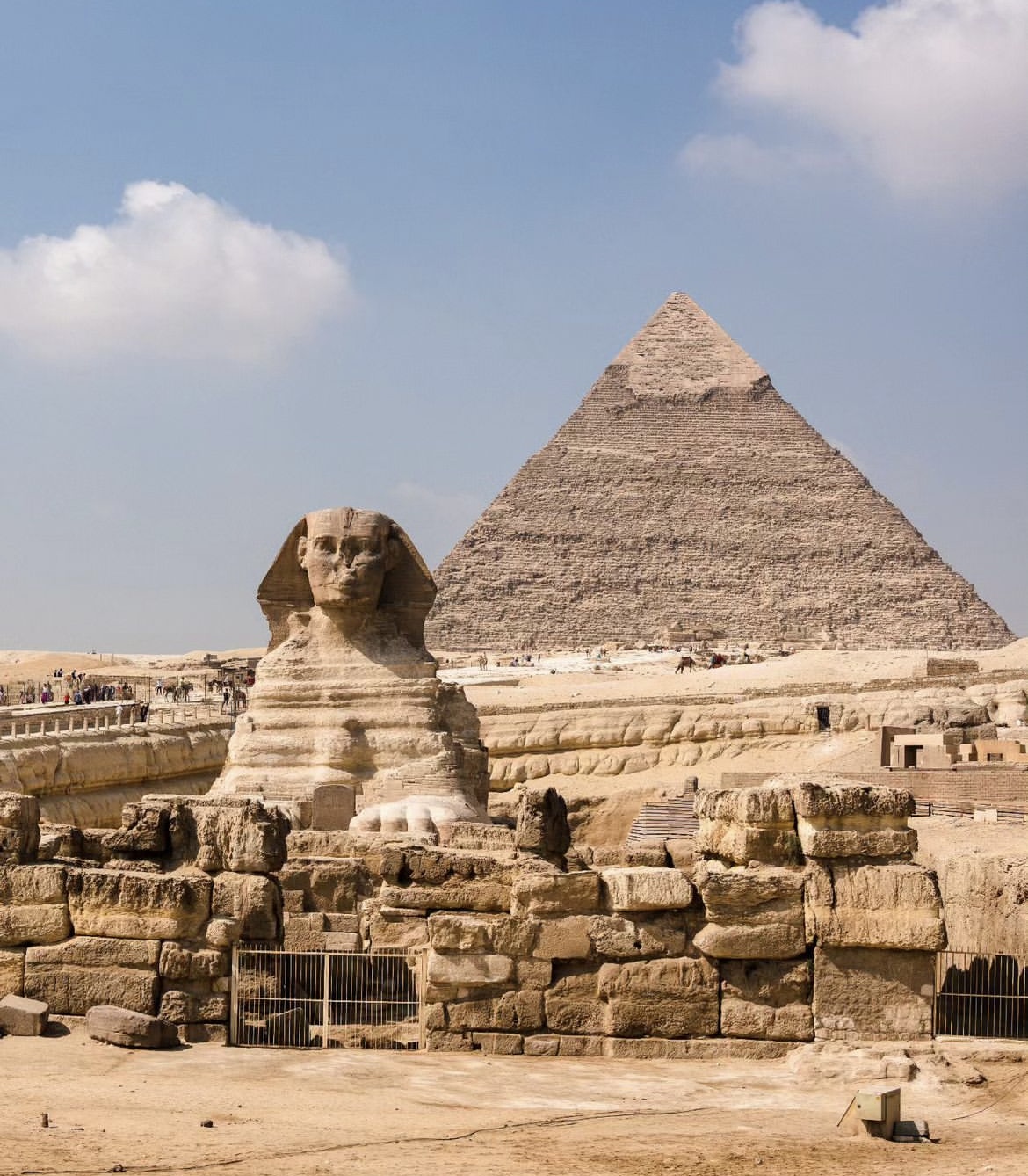
Nestled among the wonders of the Giza Plateau, the Pyramid of Khafre stands as a testament to the intricate relationship between ancient Egypt’s grandeur and its deep spiritual beliefs. Second in size only to the Great Pyramid of Giza, the Pyramid of Khafre, named after Pharaoh Khafre, captivates visitors with its regal presence and enigmatic features. This authoritative blog post will delve into the mysteries and significance of the Pyramid of Khafre, shedding light on its construction, symbolism, and timeless allure.
1. Architectural Mastery and Mysteries
Built during the Fourth Dynasty of the Old Kingdom, around 2570-2544 BCE, the Pyramid of Khafre showcases remarkable architectural achievements. What sets it apart is the enduring casing stones at its pinnacle, which preserved the pyramid’s original polished limestone appearance, hinting at the pyramid’s once-glittering splendor.
Interestingly, the Pyramid of Khafre appears taller when viewed from a distance due to its higher placement on the bedrock and the illusion created by the surrounding landscape. The construction techniques employed in its creation remain a subject of debate, with theories ranging from ramps to lever systems.
2. The Sphinx: Guardian of Mystery
Adjacent to the Pyramid of Khafre stands the iconic Sphinx, a colossal limestone statue with the body of a lion and the head of a pharaoh, believed by many to represent Khafre himself. The Sphinx’s role in ancient Egyptian beliefs and its potential connections to the pyramid’s purpose continue to intrigue researchers and enthusiasts alike. Some suggest the Sphinx might have served as a guardian or protective entity, watching over the tomb and its treasures.
The Sphinx’s precise age, purpose, and the significance of its missing nose remain topics of fascination and speculation.
3. Spiritual Significance and Funerary Complex
In the context of ancient Egyptian belief systems, the Pyramid of Khafre held profound spiritual significance. It was designed as a monument that would facilitate the pharaoh’s journey to the afterlife, and its orientation was aligned with cardinal points, reflecting the pharaoh’s connection to the cosmos.
The pyramid’s complex layout included a valley temple, a causeway, and a mortuary temple, all integral parts of the pharaoh’s journey to the afterlife. These structures housed elaborate rituals, ceremonies, and offerings intended to secure Khafre’s eternal existence.
4. Preservation and Ongoing Discoveries
The Pyramid of Khafre has experienced a long history of exploration and excavation. In modern times, advanced technologies have allowed researchers to peer into its hidden chambers and passages without damaging the monument. Scans have revealed additional chambers and passages within the pyramid, raising questions about their purpose and potential significance.
Moreover, ongoing research continues to deepen our understanding of Khafre’s reign, his connection to the pyramid, and the broader context of ancient Egyptian society.
Pyramid of Khafre FAQs
1. What is the Pyramid of Khafre? The Pyramid of Khafre is the second-largest pyramid at the Giza complex in Egypt. It is one of the three main pyramids and is named after Pharaoh Khafre (also spelled Chephren), who ruled during the Fourth Dynasty of the Old Kingdom of Egypt.
2. How does the Pyramid of Khafre compare to the Great Pyramid? The Pyramid of Khafre is slightly smaller than the Great Pyramid of Khufu. It was built on a higher elevation, giving it the illusion of being taller when viewed from certain angles. It is also distinguished by the remnants of its original casing stones near the top.
3. What are the dimensions of the Pyramid of Khafre? The Pyramid of Khafre originally stood at a height of around 143.5 meters (471 feet), with a base measuring approximately 215.5 meters (706 feet) on each side. It has a more intact upper casing compared to the Great Pyramid.
4. How was the Pyramid of Khafre built? The construction techniques used for the Pyramid of Khafre are believed to be similar to those of the Great Pyramid. Limestone blocks were quarried and transported to the construction site. Ramps were likely used to transport the massive stones to their intended positions.
5. Does the Pyramid of Khafre have any internal chambers? Yes, the Pyramid of Khafre has an internal layout that includes a descending corridor leading to a subterranean chamber. However, unlike the Great Pyramid, the Pyramid of Khafre does not have a well-defined burial chamber within the superstructure. It is thought that Khafre’s burial took place in a tomb cut into the bedrock beneath the pyramid.
6. What is the significance of the Pyramid of Khafre? The Pyramid of Khafre is significant for its historical and architectural importance. It is part of the Giza pyramid complex, which collectively showcases the advanced engineering skills and monumental ambitions of ancient Egyptian civilization.
7. What is the relationship between the Pyramid of Khafre and the Great Sphinx? The Pyramid of Khafre is located near the Great Sphinx of Giza. Some scholars believe that the Sphinx was constructed during the reign of Khafre and might have been intended as a symbol of the pharaoh’s authority. The proximity of the pyramid and the Sphinx adds to the overall mystique of the Giza complex.

